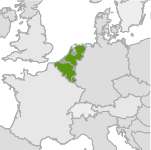Dragon-stem goblet
Dragon-Stem Goblet
The video shows the three parts of this goblet—foot, stem, and cup—being made and placed “on hold” in an oven. After the foot has been attached to a pontil, the other parts are added using small amounts of molten glass (‘glue bits’) to join them.
Transcript
The foot begins with a tiny gather of clear glass. A rather thick bubble is lowered into a 12-rib optic mold. Constrictions are made. A tiny amount of freshly gathered glass is added to the tip, and a merese is created. A merese is made by flattening the glass, making it slightly conical, putting a blade on either side, and squeezing. Another bit of glass is added to the tip. It's reheated briefly to make it perfectly symmetrical. The glass is flattened at its end. The constriction made deeper, the blade placed on either side, and the outer disc is pulled to create a narrow stem.
A second bubble of glass is lowered onto the tip of the avolio. After reheating, the tip is pulled slightly and a constriction is formed. And this constriction will allow a hole to be created on the end of the bubble. The hole is opened somewhat, reheated, and the soffietta used to inflate the sides of the bubble. The vessel has a folded rim at the bottom of its foot. This is a double thickness of glass that is attractive and much stronger than a single layer. The foot is broken free of its blowpipe and placed in an annealing oven. The oven idles at a temperature of about 950 degrees.
The cup begins with a substantial gather of clear glass. It's marvered. Then the blowpipe is held upward as the bubble is blown into the glass. This will ensure that the tip of the bubble is somewhat thinner than the sides. The pipe is held downward to elongate the glass. It's marvered, slightly tapered. The glass is elongated, excess glass trimmed free, and another gather of glass is added to the tip. This is pushed upward along the sides of the bubble. It's immediately pressed into the 12-ribbed dip mold or optic mold and, after reheating, the snipping begins to create the broken ribbing pattern.
There are two sets of snipped ribs. The glass is reheated and inflated. A constriction is begun near the blowpipe. The glass is spun to elongate the bubble. And blowing and tooling continue to create a narrow constriction near the blowpipe, and to give the bubble its proper shape. A tiny bit of glass is added to the tip of the bowl, and a merese created. A bubble of glass, dipped into the 12-ribbed optic mold, is lowered into place. A narrow constriction is immediately made near the merese. And two more constrictions made: one decorative and the outermost will allow the excess glass to be broken free. The cup is transferred to a punty, or pontil. The narrow constriction near the blowpipe allows for easy, clean breaking.
A tiny gather of glass collected on the end of a small metal rod is added. This creates a thin, thin spiral thread. Edges of dragon stem goblets like this are exceedingly thin and require a special lip-thinning procedure. The thick glass is pulled outward, a new constriction is made, and the thick glass is broken away. After reheating, the opening process begins with the dilating of the hole to a diameter of about an inch. After reheating, the soffietta is used to inflate the glass. And after a last reheat, the vessel is given its final shape.
The core of the body of the dragon is decorated with a yellow and a red cane. These are added to a gather of clear glass. The canes are reheated and marvered in. The gather is elongated and cut into segments. To make the body of a dragon, one of these segments is attached to the end of a punty, and clear glass is thinly gathered over it. The glass is plunged into an 18-ribbed optic mold. And as the glass is elongated, the punty is twisted, and this is wrapped on a mandrel. A constriction is made near the punty. And the spiral is reheated. The coil, or spiral, is wrapped upon the stem, shaped, a small gather of glass is added to its base. On this, the foot will eventually sit. But for now, a punty will be attached. And it's with this that the dragon will be held as it's completed.
The beak is made by adding a small gather of glass to the tip of the stem. It's divided in two, flattened, and the lips are pulled outward. After a reheat, the beak has given its final shape. The eyes are made: A teeny gather of aqua glass is used for the first eye, and the second eye. And larger gathers of aqua glass are used for the wings. The glass is flattened, and the glass is pulled from both ends. And the shears are used to create the feather pattern. A comb is added to the top of the head. After ensuring that all parts of the dragon are well over 1,000 degrees, it's broken off into the annealer.
The assembly begins with a hot punty, to which the foot is attached. And when it's properly centered, a teeny bit of glass is added to the knop, the dragon picked up and stuck on the so-called 'glue bit'. Another glue bit is added from above. The cup picked up and pressed on. The vessel is flashed in the furnace so that all parts are well over 1,000 degrees Fahrenheit. It's lowered into the annealing oven, the punty tapped gently. It breaks free, leaving the dragon stem goblet in the annealer, ready for slow cooling.
See all: Browse by Map


